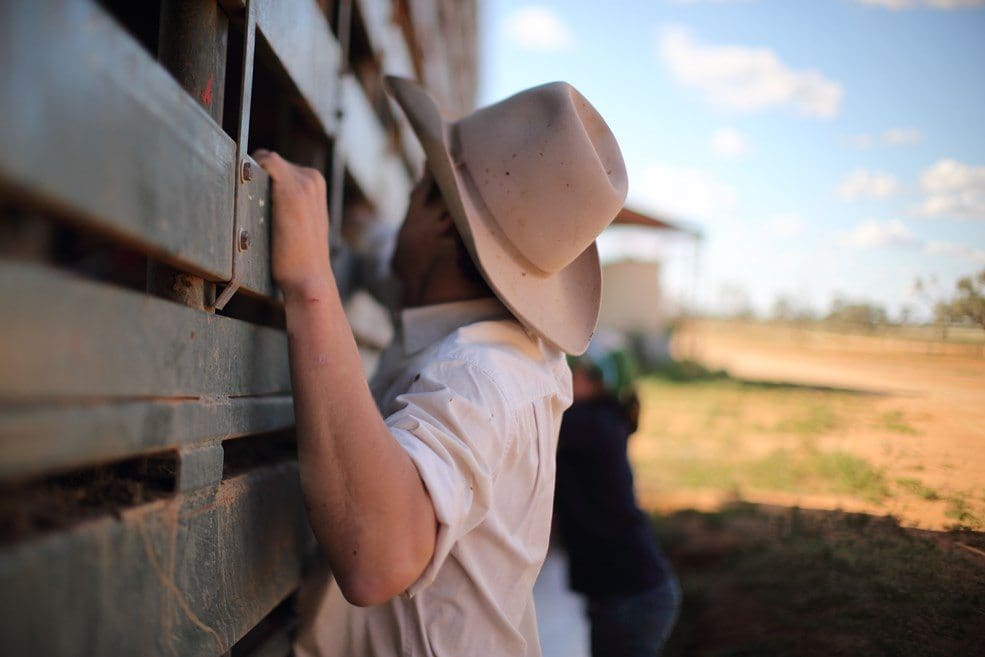
THE need for viligance when transporting livestock was reinforced during a “Fit to load?” webinar hosted by Cattle Council of Australia and Beef Central on Friday.
The hour-long webinar attracted almost 220 industry stakeholders from all states and territories. Readers can access a recorded version of the webinar to replay at their leisure, by clicking here.
The underlying message from a number of speakers was, “If in doubt, leave it out,” – or a variation on that theme: “If in doubt, check it out.”
The impact of drought currently sweeping a large expanse of eastern Australia only amplified responsibilities when transporting stock, the audience heard.
Transport high welfare focus for consumers

Pip Band
Meat & Livestock Australia’s program manager for industry sustainability framework, Pip Band, told the seminar that it was very clear from both consumer research and direct consultation with stakeholders as part of the Beef Sustainability Framework project that a key concern for consumers, customers and other stakeholders was that animals are transported safely, and with a focus on animal welfare.
“It’s an issue that consumers feel quite connected with,” she said, “and they feel it is something that they can ‘vote with their wallets’ over, if they don’t think animals are being transported domestically as well as they should be.”
“Maintaining that community trust around transportation is something that all industry stakeholders are keen to protect,” she said.
Fit to Load guide under review
A review of the industry’s Fit to Load guide was currently underway, Ms Band said.
The national guide, last updated in 2012, was originally developed to help producers, livestock carriers, agents and buyers to determine the suitability of livestock for transport, in accordance with requirements under the Australian Animal Welfare Standards for the land transport of animals.
“Where we are up to in that process is that key stakeholder groups including industry, retailers, welfare groups and others have been invited to provide written submissions,” Ms Band said.
“MLA has established a working group to review those submissions, and the next steps from there will depend in the content and nature of materials received from those interest groups.”
If stakeholders were advocating for minimal or no changes to the guide, then the working group would simply finalise those minor modifications and seek industry approval. However, if significant changes to the guide are requested, those changes will be considered by an expert panel to determine their benefit to industry and outcomes, for inclusion in the document.
Ms Band said from early feedback from stakeholders, there was little real appetite for wholescale change to the guide. “People appear to be really happy with the guide in its current form, and its likely to be only a few minor changes.”
The current version had been ‘hugely successful,’ she said.
“It’s actually the most requested publication that MLA has ever produced, with 60,000 copies currently in circulation. It’s incredibly well supported by all sectors of the industry, from transporters, retailers, on farm, through to animal welfare groups.”
It was hoped that the updated guide would be completed before the end of this year.
Producers face range of decisions
Livestock Biosecurity Network’s biosecurity and extension manager Rachael O’Brien told the webinar there were a range of situations where a producer might have an animal in the yards that was not fit to load.
“Sometimes an animal can go through the yards without being noticed. People processing cattle working on one particular side might miss a beast that has an injury on the other side, until it is at the point of going on the truck. Animals can sometimes be injured in the yards themselves – it’s unfortunate, but it does happen – and its important to build capacity so people know what to do when those situations arise.”
Another common topic of discussion was producers who were unsure whether a particular beast was, or was not fit to load.
“The guides (both the CCA’s combined version, and the MLA and Livecorp versions) are a great little resource to have in the Toyota dashboard, to have a look at while people are in the yards,” Ms O’Brien said.
“It’s important to understand that we all have different perspectives of what is, and isn’t fit to load. Something that somebody – eve an experienced producer – could have a look at, and allow through, may be different from what somebody else at the other end may judge.”
Another aspect raised by Ms O’Brien was that feedback was not always forthcoming from destinations, if an animal arrived injured, and it could be unclear whether the injury happened during the journey itself or beforehand.
“But it really is important for producers to understand what these decisions can do to their business, and reputation – as well as the bigger picture industry-wide reputation, as well,” she said.
So what can producers do if they find themselves in a situation with an injured animal?
“We really cannot stress enough how important it is that that animal is not loaded. If there is any doubt in your mind that that animal should not go on the truck, leave it out,” Ms O’Brien said.
With regard to what happens to the animal afterwards, if it was injured quite badly it may need euthensasia, or treatment, allowing the animal to heal before transport at some future time, or even getting a vet to visit and make an assessment.
Ms O’Brien said there was a tendency in times of drought for more frequent loads containing cattle that might be ‘questionable.’
“The key message for producers is to try not to get into that position, by making transport decisions a lot earlier – but I know that can be difficult, under the circumstances.”
She said there were occasions when drought cattle had to be held over somewhere and fed up, before they could continue their journey.
Need for vigilance in saleyards
Speaking from a saleyards operations perspective, Dubbo Regional Saleyards manager Ross McCarthy reminded the webinar participants that times had changed right across the livestock industry, and what might have been considered acceptable practise a decade or two might not be today.
“The world is much more connected, via the internet, and customer and consumer expectations are much higher today. Consumers today have much higher expectations about animal welfare, and pretty much everyone has a camera these days,” he said.
“Through social media these images can be transmitted virtually anywhere in the world, pretty much instantly. This makes the saleyards environment a much more transparent place, and consumers are much more interested in visiting sites like this to see where their food comes from.”
“But this is not something to be feared, provided everyone is doing the right thing, and it starts on the farm,” Mr McCarthy said.
“Today, millions of dollars each year is spent on promoting the red meat industry, yet one bad decision by an individual in the chain during transport can undo a lot of good work. Some people may view the value of an animal simply in terms of dollars, however we should be also seeing the broader ramifications for industry if we don’t proactively engage on these animal welfare issues,” he said.
“Animals found to be unfit to load have to be either treated or euthanised at the saleyards, and the saleyard is not the best place for this – it uses up staff resources that could be better occupied elsewhere, and adds to running costs. These unfit animals are not a good reflection on the individuals involved – be they producers, transporters, agents, or the yard staff themselves.”
On arrival at the yards, unfit animals could not be offered for sale, sold, purchased or transferred on a journey that would cause further harm, he said.
Mr McCarthy pointed to a range of tools available for producers to help them make better decisions over fitness to load livestock: The Cattle Council of Australia’s Fit to Load and Fit to Export guide; MLA’s original Fit to Load guide; and the Australian Animal Welfare Standards and Guidelines for livestock at saleyards and depots (access details to these resources at base of this page).
Second opinions offered
The webinar also discussed the opportunity to share photos or video of animals where fitness to load came into question, with processor or feedlot livestock buyers, or veterinarians.
Three of Australia’s largest multi-site beef processors and lotfeeders – JBS, Teys and NH Foods – confirmed that producers consigning cattle to them, who were uncertain about the transport status of certain animals, were welcome to share images or video with their senior livestock personnel, for consultation.
A number of independent veterinary service providers also offer free consultation on animals in determining fitness to load. One of those is Food and Veterinary Services Pty Ltd vet Elizabeth Wilcock, who launched her company’s free Fit to Load consultation service during Beef 2018 in Rockhampton last month. Dr Wilcock’s contact details can be obtained from the company website www.foodandvetservices.com.au
Animal Health Australia’s senior manager for biosecurity, Dr Rob Barwell, said such consultation was a good idea, but he was not sure how widespread or active the process was yet.
“There can be the potential for doubt in some circumstances, so having a second expert opinion on what might be happening with a particular animal would definitely make sense,” he said.
CCA director Peter Hall said it was certainly not yet a common practice for producers to send videos or photos of animals to a processing plant or vet, but there was evidently a little bit of it going on.
“The standards are pretty clear about what is and isn’t fit to travel, but if a producer has an issue with interpreting those standards using the tools that are available, then seeking some guidance from a vet makes sense. It’s a path we may have to go down more frequently, because at the end of the day it is all about chain of responsibility,” Mr Hall said.
“If any producer wants reassurance that they are making the right judgement, I can only recommend that they consult with a vet.”
Experienced Queensland livestock transporter John Lethbridge, from Hughenden, focused on moderating stress and preparation of livestock before loading during his presentation.
“In my experience, the decisions about fitness to load based on physical aspects like injury or sickness are reasonably straightforward. By far the biggest problem we have from a transporters perspective is the preparation of the animals for transport, where producers simply haven’t allowed enough time to prepare them properly,” he said.
“Not allowing enough time to prepare not only compromises a thorough inspection of the animals that might be physically doubtful, but adds additional stress to animals through allowing time for them to settle down – and the cattle can suffer during transit because of that. The real issues arise where preparation has not been done properly, pre-shipment.”
Resources:
Below are some resources producers can use when considering fitness to load of livestock before transport:
- Cattle Council of Australia’s combined domestic and live export Fit to Load and Fit to Export guide
- MLA’s original Is it fit to Load? guide
- Australian Animal Welfare Standards and Guidelines for livestock at saleyards and depots
- Australian Animal Welfare Standards and Guidelines for livestock land transport
- MLA Fit to Load video
Click this link to access a recording of Friday’s Fit to Load webinar.
